Items
Site
The Medicine Chest
keywords is exactly
measure
-
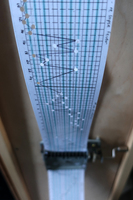
Listen Laennec
"In this work, the temperature graphs of individuals suffering from malaria, yellow fever, trypanosomiasis and tickborne-relapse fever – all viewed as ‘tropical’ and treatable by the contents of the medicine chest – were converted into a musical score. I punched the strips of paper of a hand-cranked musical box mechanism with holes that corresponded to the graphs – the vertical axis representing temperature variations and the horizontal axis representing the approximate number of days the fever is said to last. The translation of these graphs into notes seems nonsensical, as we do not listen for a temperature; we measure it by feeling a forehead or taking a reading with a thermometer. The practice of listening has, however, been part of the history of medicine since the days of Hippocrates (c.460–c.370 BC), when physicians performed auscultations of the lung and heart by placing their ear directly on the patient’s chest' (Liebenberg 2021: 265). -

Miscast (Lane reflects)
"Where viewers had to walk over a floor of vinyl tiles printed with photocopied newspaper articles and photographs of the San, Lane reflected on another archaeological parallel: ‘just as the texts and images on the floor represent the debris of a particular history, so too do the artefacts strewn across the surface of a site’ (Lane 1996: 7). Yet in trying to define sites and their history, archaeologists feel ‘they can tread on the debris of their own or others’ ancestors with equanimity, colonizing that space for themselves’ (Lane 1996: 7)" (Liebenberg 2021: 172 - 174). -
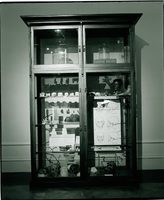
Miscast (installation detail)
"In juxtaposing instruments that are still being used (such as the scalpel and the camera) with ones that are not (the Von Luschan skin colour chart and the anthropometric measuring rods), Skotnes set up an opportunity for science to reflect on its past and on the activities and objects of its present, enabling a mode of self-reflexivity that is not a standard part of its day-to-day practices. Through curatorship, she exposed disciplinary practitioners to naturalisations and blind spots within their fields and sensitised them to these previously occluded characteristics" (Liebenberg 2021: 172). -
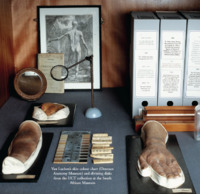
Page 79 of the Curiosity CLXXV catalogue.
"Created by Felix von Luschan, an Austrian doctor, anthropologist, explorer, archaeologist and ethnographer in the early 20th century, the chart, known as the Von Luschan chromatic scale (...) was used to classify skin colour and featured as a tool in race studies and anthropometry of the time. Forgotten by its current department staff and students, its presence draws attention to the role of medicine and science in the apartheid agenda and to the larger racist scientific practices of measuring and classifying human physical differences in the 19th and 20th centuries to produce a ‘typology of race’ (Sturken & Cartwright 2018: 351–352). To support such theories, object collections in scientific university departments worldwide also featured collections of human remains; tools for measuring the size and shape of skulls; and charts detailing various physiognomic features (Sturken & Cartwright 2018: 351 – 352)" (Liebenberg 2021: 122 - 125). -
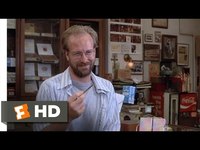
Weighing Smoke
PAUL That’s the man. Well, Raleigh was the person who introduced tobacco in England, and since he was a favourite of the Queen’s – Queen Bess, he used to call her – smoking caught on as a fashion at court. I’m sure Old Bess must have shared a stogie or two with Sir Walter. Once, he made a bet with her that he could measure the weight of smoke. DENNIS You mean, weigh smoke? PAUL Exactly. Weigh smoke. TOMMY You can’t do that. It’s like weighing air. PAUL I admit it’s strange. Almost like weighing someone’s soul. But Sir Walter was a clever guy. First, he took an unsmoked cigar and put it on a balance and weighed it. Then he lit up and smoked the cigar, carefully tapping the ashes into the balance pan. When he was finished, he put the butt into the pan along with the ashes and weighed what was there. Then he subtracted that number from the original weight of the unsmoked cigar. The difference was the weight of the smoke. TOMMY Not bad. That’s the kind of guy we need to take over the Mets. PAUL Oh, he was smart, all right. But not so smart that he didn’t wind up having his head chopped off twenty years later. (Pause) But that’s another story. -
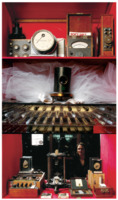
Capitance
"Strategies such as juxtapositioning also served to highlight poetic and emotive qualities in fields not known for encouraging them, as in a cabinet curated by Langerman titled Capitance. This featured a range of instruments from the Physics department used to measure electrical currents (galvanometers, capacitors and Wheatstone bridges); a crystal goniometer measuring crystal face angles and crystal 175 from the crystal collection in Geological Sciences; M.R. Drennan’s models of the human embryo and a wax model of flesh; and a white tutu from the School of Ballet. In combining this selection of scientific instruments with a tutu, Langerman made allowance for the materials to be considered in a more poetic light, inviting the viewer to consider how a grand jeté defies the laws of physics, for example" (Liebenberg 2021: 186). -

Measuring Niagara falls with a teaspoon
Georgian silver spoon drawn to the height of Niagara Falls. -

Miscast (instruments of measurement)
"Along with the guides that regulated practices and protocols to stabilise and standardise an individual’s response to unfamiliar and disorienting sights (Kennedy 2013: 42), the gender, class and ethnicity of the observer were also of importance , as was the use of ‘ever more sophisticated instruments and calculations designed to minimize the intrusion of subjectivity into the reporting of information’ (Driver 2001: 55). By regulating who was doing the viewing, stipulating what should be viewed and how and supplying tools to measure these observations, scientific institutions promoted an authoritative ‘way of seeing’ in the field that differentiated the scientific view from that of the ordinary traveller (Driver 2001: 49)" (Liebenberg 2021: 109). -

Avoided Object
Photographs of the sky above the Imperial War Museum taken with the camera that belonged to Hoess, commandant of Auschwitz


